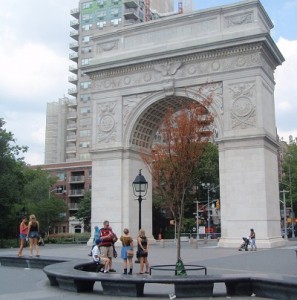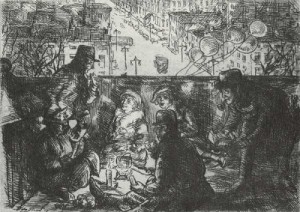99 Years Ago: The Washington Square Arch Conspiracy, January 23, 1917

The Washington Square Arch in Washington Square Park is in some ways the heart of the Village. The white marble structure was designed by renowned architect Stanford White and built in 1890-1892. It replaced an earlier, temporary privately-funded arch, made of plaster and wood, that was erected in 1889 to commemorate the centenary of George Washington’s inauguration. This original arch was located just north of the park, and spanned 5th Avenue.
The park itself was once a marsh fed by the Minetta Brook, and located near an Indian village known as Sapokanikan. In 1797 the City’s Common Council acquired the land – which was then very much the countryside and not part of what was New York City – for use as a “Potter’s Field” and for public executions. It became Washington Military Parade Ground in 1826, and then a public park in 1827.
Gentrification soon followed, and one of the grandest examples of Greek Revival architecture – the rowhouses located along Washington Square North – were constructed mostly in the 1830s as fashionable residences for New York’s elite. Novelists Henry James and Edith Wharton; and artists Edward Hopper, William Glackens, and Thomas Eakins all lived here at one time or another.
But the Village in general – and Washington Square in particular – has always been a place for radicals, rogues, and assorted troublemakers. (It still is!) And 99 years ago tomorrow, some of them – fueled by alcohol no doubt – made an attempt to declare a “free and independent republic” in Washington Square. Among them was artist John Sloan, who captured the event in an etching. As per this prior Off the Grid post:

Poet Gertrude Drick, painters John Sloan (who drew the etching above) and Marcel Duchamp, and Provincetown Playhouse actors Russell Mann, Betty Turner, and Charles Ellis got into the arch and up the spiral staircase through an unlocked door. They became known as the “Arch Conspirators” after that snowy winter’s day.
At this January 23, 1917 event, Drick read a declaration of independence for the “Free and Independent Republic of Washington Square” with the intent of having a neighborhood free from mainstream convention. The Daily Plant, the paper of the City’s Parks Department, writes: “These six so-called “Arch Conspirators” then spread out blankets, hung Chinese lanterns, tied red balloons to the arch’s parapet, sipped tea, shot off cap pistols, and conversed until dawn.”
You can read more about Bohemia and Greenwich Village on our Resources page. You might also be interested in checking out Andrea Barnet’s List of Bohemian Hang Outs in the Village from a past program hosted by GVSHP.
The event was soon forgotten, however it’s clear that the spirit of these artists lived on in the Village for decades thereafter. You can read more about Greenwich Village and its long-famed connection to the arts on our Resources page: Art in the Village, 1930s and The “Beat” Movement and Happenings, 1950s-1960s.
Today people are not allowed atop the arch, but there is still plenty going on in the park.
